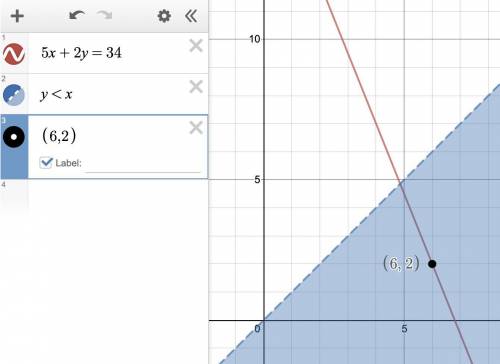Answers:
Ben = 6Max = 12Mitchell = 2Christion = 2Daniel = 18Each count above refers to the number of baskets made for the given player.
Explanation:
For each player, let the following variables represent how many baskets were made
B = BenM = MaxT = MitchelC = ChristionD = DanielSo for example, if D = 10, then this means Daniel made 10 baskets. Though for now, we're not sure what number replaces D or any given letter.
"Daniel remembers that he made three times as many baskets as Ben" tells us that D = 3B is one equation
We know another equation is M = B+6 since Max made six more baskets than Ben
Another equation is C = T because these two students (Christion and Mitchell) made the same number of baskets.
We also know that T < B since Mitchell made fewer baskets compared to Ben.
Altogether the boys made 40 baskets total, so B+M+T+C+D = 40
We have these five mathematical statements
D = 3BM = B+6C = TT < BB+M+T+C+D = 40Let's focus on the last equation
B+M+T+C+D = 40
B+M+T+C+3B = 40 plug in D = 3B
4B+M+T+C = 40
4B+M+T+T = 40 plug in C = T
4B+M+2T = 40
4B+B+6+2T = 40 plug in M = B+6
5B+6+2T = 40
5B+2T = 40-6
5B+2T = 34
Now let's solve for T
5B+2T = 34
2T = 34-5B
2T = -5B+34
T = (-5B+34)/2
T = (-5B)/2 + 34/2
T = -2.5B + 17
We've eliminated everything but two variables at this point.
Let's say that x replaced B and y replaces T
We get the equation y = -2.5x + 17
If you graph this equation along with y = x, you'll find that the two equations intersect at roughly (4.857, 4.857)
Since we want T < B, this means we want y < x to be the case. The line y = -2.5x+17 goes downhill as we move from left to right. If x is smaller than 4.857, then x >= y. Otherwise, if x is larger than 4.857, then y < x
Furthermore, looking at a table of values for this equation shows that only (x,y) = (6,2) is a point on y = -2.5x+17 such that both x and y are positive and x is the larger value, and they are both integer coordinates.
All of this means that when B = 6, this pairs with T = 2. No other number pair is possible for these two students.
We then use this to find the other player's basket count
D = 3B = 3*6 = 18M = B+6 = 6+6 = 12C = T = 2So we have the following results
B = 6M = 12T = 2C = 2D = 18As a check,
B+M+T+C+D = 6+12+2+2+18 = 40
which confirms our answers.
9514 1404 393
Ben: 6Daniel: 18Max: 12Mitchell: 2Christion: 2Step-by-step explanation:
Let x and y represent baskets made by Ben and Mitchell, respectively. Then Daniel made 3x baskets, Max made (x+6) baskets, and Christion made y baskets. The total number is ...
x + 3x +(x+6) +y +y = 40
5x +2y = 34 . . . . . . . . . . . subtract 6
The other constraint on the solution is ...
y < x . . . . . . . . . Mitchell made fewer baskets than Ben
__
We can see that 34 differs from a multiple of 5 by an even number, so (by inspection) we determine that (x, y) = (6, 2) is a solution to the equation. (It is also a solution to the inequality.)
Other possible solutions will require y increase by 5 as x decreases by 2, so those are ...
(x, y) = {(6, 2), (4, 7), (2, 12), (0, 17)}
The only (x, y) pair that satisfies the inequality is the first one: (x, y) = (6, 2). Hence the numbers of baskets are ...
Ben: 6Daniel: 18Max: 12Mitchell: 2Christion: 2